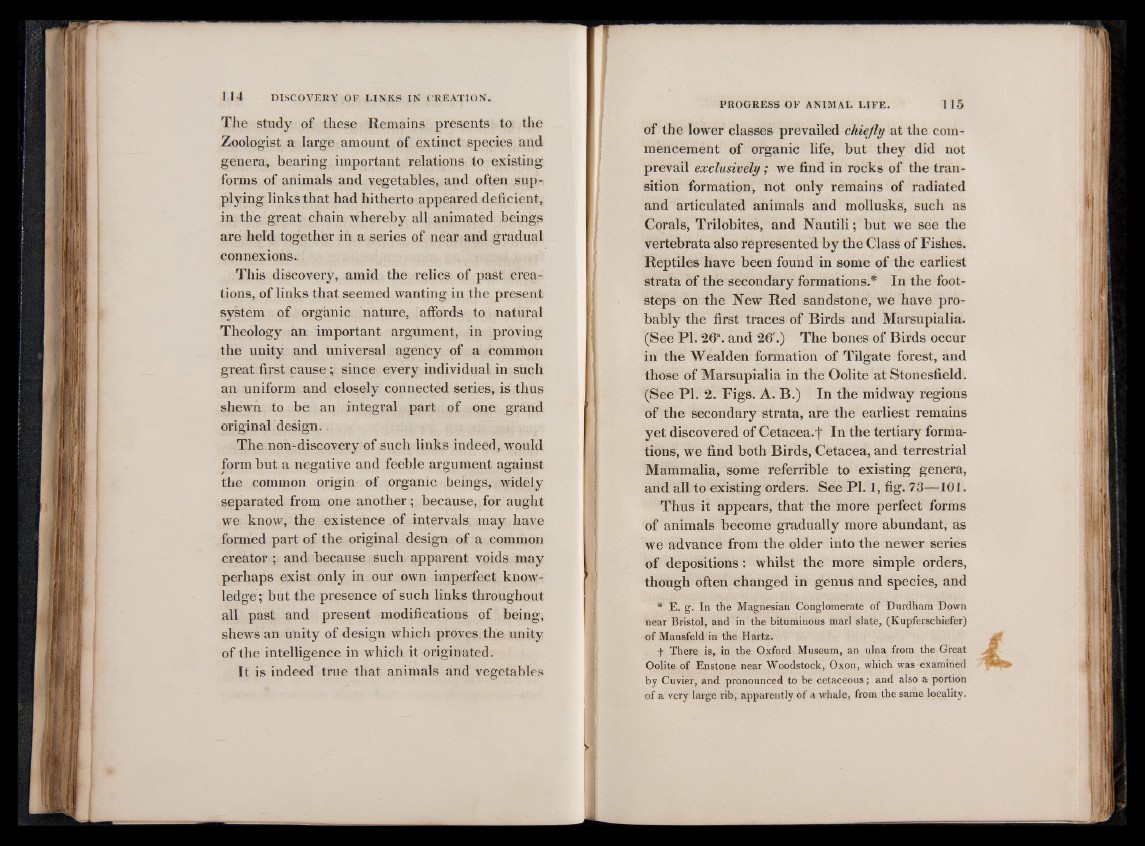
1 14 DISCOVERY OF LINKS IN CREATION.
The study of these Remains presents to the
Zoologist a large amount of extinct species and
genera, bearing important relations to existing
forms of animals and vegetables, and often supplying
links that had hitherto appeared deficient,
in the great chain whereby all animated beings
are held together in a series of near and gradual
connexions.
This discovery, amid the relics of past creations,
of links that seemed wanting in the present
system of organic nature, affords to natural
Theology an important argument, in proving
the unity and universal agency of a common
great first cause ; since every individual in such
an uniform and closely connected series, is thus
shewn to be an integral part of one grand
original design.
The non-discovery of such links indeed, would
form but a negative and feeble argument against
the common origin of organic beings, widely
separated from one another; because, for aught
we know, the existence of intervals may have
formed part of the original design of a common
creator ; and because such apparent voids may
perhaps exist only in our own imperfect knowledge;
but the presence of such links throughout
all past and present modifications of being,
shews an unity of design which proves the unity
of the intelligence in which it originated.
It is indeed true that animals and vegetables
PROGRESS OF ANIMAL L IF E. 1 15
of the lower classes prevailed chiefly at the commencement
of organic life, but they did not
prevail exclusively; we find in rocks of the transition
formation, not only remains of radiated
and articulated animals and mollusks, such as
Corals, Trilobites, and Nautili; but we see the
vertebrata also represented by the Class of Fishes.
Reptiles have been found in some of the earliest
strata of the secondary formations.* In the footsteps
on the New Red sandstone, we have probably
the first traces of Birds and Marsupialia.
(See PI. 26\ and 26'.) The bones of Birds occur
in the Wealden formation of Tilgate forest, and
those of Marsupialia in the Oolite at Stonesfield.
(See PI. 2 . Figs. A. B.) In the midway regions
of the secondary strata, are the earliest remains
yet discovered of Cetacea.t In the tertiary formations,
we find both Birds, Cetacea, and terrestrial
Mammalia, some referrible to existing genera,
and all to existing orders. See PI. 1, fig. 73— 1 0 1 .
Thus it appears, that the more perfect forms
of animals become gradually more abundant, as
we advance from the older into the newer series
of depositions: whilst the more simple orders,
though often changed in genus and species, and
* E. g. In the Magnesian Conglomerate of Durdham Down
near Bristol, and in the bituminous marl slate, (Kupferschiefer)
of Mansfeld in the Hartz.
f There is, in the Oxford Museum, an ulna from the Great
Oolite of Enstone near Woodstock, Oxon, which was examined
by Cuvier, and pronounced to be cetaceous; and also a portion
of a very large rib, apparently of a whale, from the same locality.